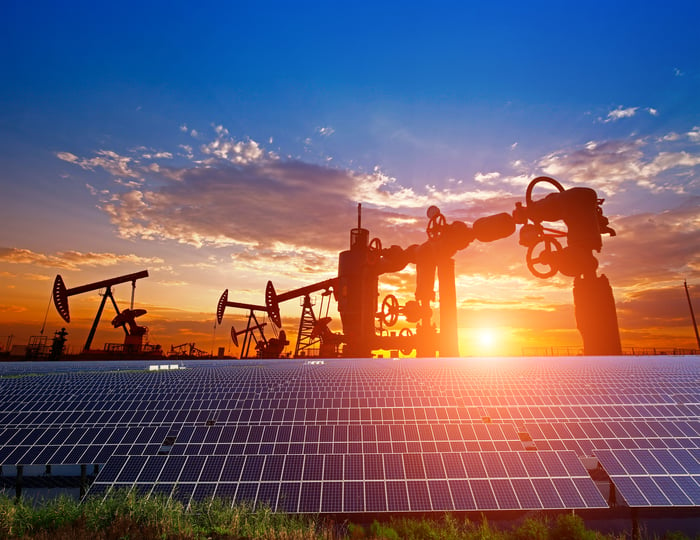Income-seeking investors have several compelling options available these days. Two of my personal favorites are diversified global infrastructure giant Brookfield Infrastructure Partners (BIP -0.80%) and wind and solar power generator TerraForm Power (TERP). I currently own both and would consider buying more of either one of these high-yielding infrastructure companies.
However, if I had to pick just one to buy, I'd choose Brookfield Infrastructure. Here's why I think it's the better choice between the two.
Check out the latest TerraForm and Brookfield Infrastructure earnings call transcripts.

Image source: Getty Images.
Comparing their financial profiles
The first factor I like to consider when comparing two companies is their financial foundation. Here's how these two stack up:
|
Company |
Dividend Yield |
Credit Rating |
Targeted Dividend Payout Ratio |
% of Cash Flow Fee-Based or Regulated |
|---|---|---|---|---|
|
Brookfield Infrastructure Partners |
4.9% |
BBB+ |
70% of cash flow |
95% |
|
TerraForm Power |
6.1% |
Ba3/BB- |
80% to 85% of cash flow |
96% |
Data source: Brookfield Infrastructure and TerraForm Power.
As that table shows, TerraForm Power currently offers investors a higher-yielding dividend, in part because it aims to pay out a larger percentage of its cash flow. Brookfield Infrastructure, on the other hand, has a higher credit rating than TerraForm, which currently has junk-rated credit. That's a differentiating factor for me because companies like Brookfield with a strong investment-grade credit rating have greater access to financing at lower borrowing costs. This factor can prove to be a competitive advantage because it gives Brookfield more flexibility to pursue growth opportunities.
Another notable difference between these two companies is how they plan to finance growth going forward. Brookfield Infrastructure is moving away from funding expansion projects and acquisitions by issuing new equity that dilutes existing investors. Instead the company plans to sell assets and reinvest those proceeds into higher-returning opportunities. TerraForm, on the other hand, sold shares last year to fund a major acquisition and expects that it will need to issue more equity in the future to achieve its growth objectives.
Considering their growth prospects
Brookfield Infrastructure is currently in the midst of a significant portfolio reshuffling program aimed at accelerating its growth rate. The company sold an electricity transmission business in Chile last year and is in the process of redeploying those proceeds into seven other opportunities. Those deals alone should grow the company's cash flow from $3.11 per share in 2018 up to an annualized run rate of $3.60 when it closes them all by midyear. Meanwhile, Brookfield Infrastructure believes that it can organically grow its cash flow per share at a 6% to 9% annual pace going forward as it benefits from inflation-linked rate increases on its contracts, volume growth within its existing assets, and the incremental cash flow it will earn as its current slate of expansion projects enter service. That rising cash flow should support distribution growth of about 5% to 9% per year. Future acquisitions, meanwhile, could further bolster the company's growth potential.
TerraForm Power, on the other hand, completed a needle-moving acquisition last year, which should give it the power to grow cash flow at a healthy clip over the next few years. In the company's view, that deal, when combined with other growth initiatives it's pursuing, and its ability to reduce costs and improve revenue at its existing assets should help support 5% to 8% annual dividend growth through 2021. However, given TerraForm's weaker balance sheet and the fact that it pays out a larger percentage of its cash flow, the company will likely need to sell more shares to capture enough of those growth initiatives to achieve its target. The risk here is that if a stock market sell-off comes at an inopportune time, the company might not be able to sell the stock it needs at a high enough price to avoid significantly diluting investors.
Another noteworthy growth-related factor is the differing opportunity sets these companies could pursue in the future. Given that TerraForm Power focuses on owning and operating wind and solar power generating facilities in North America and Western Europe, the company's growth prospects are somewhat limited. While there is an enormous opportunity set in those regions, the company doesn't have the same flexibility as Brookfield Infrastructure, which has a much wider mandate. Not only can Brookfield Infrastructure continue expanding its current infrastructure platforms in transportation, energy, utilities, and data infrastructure, the company can pursue new opportunities in areas such as water as well as faster-growing geographies like China and India. That gives the company greater flexibility in driving growth, which could create more value for its investors over the long term.
There's more to like at Brookfield Infrastructure
While I like and own both companies, I think Brookfield is a better investment opportunity. Not only does it have a stronger financial profile, it has better growth prospects thanks to its diversification and the ability to self-fund expansion going forward, which I think will enable it to generate higher total returns for investors over the long term. That's why I currently have a much larger allocation of Brookfield Infrastructure in my portfolio, and would likely add to my position before buying more TerraForm Power.





